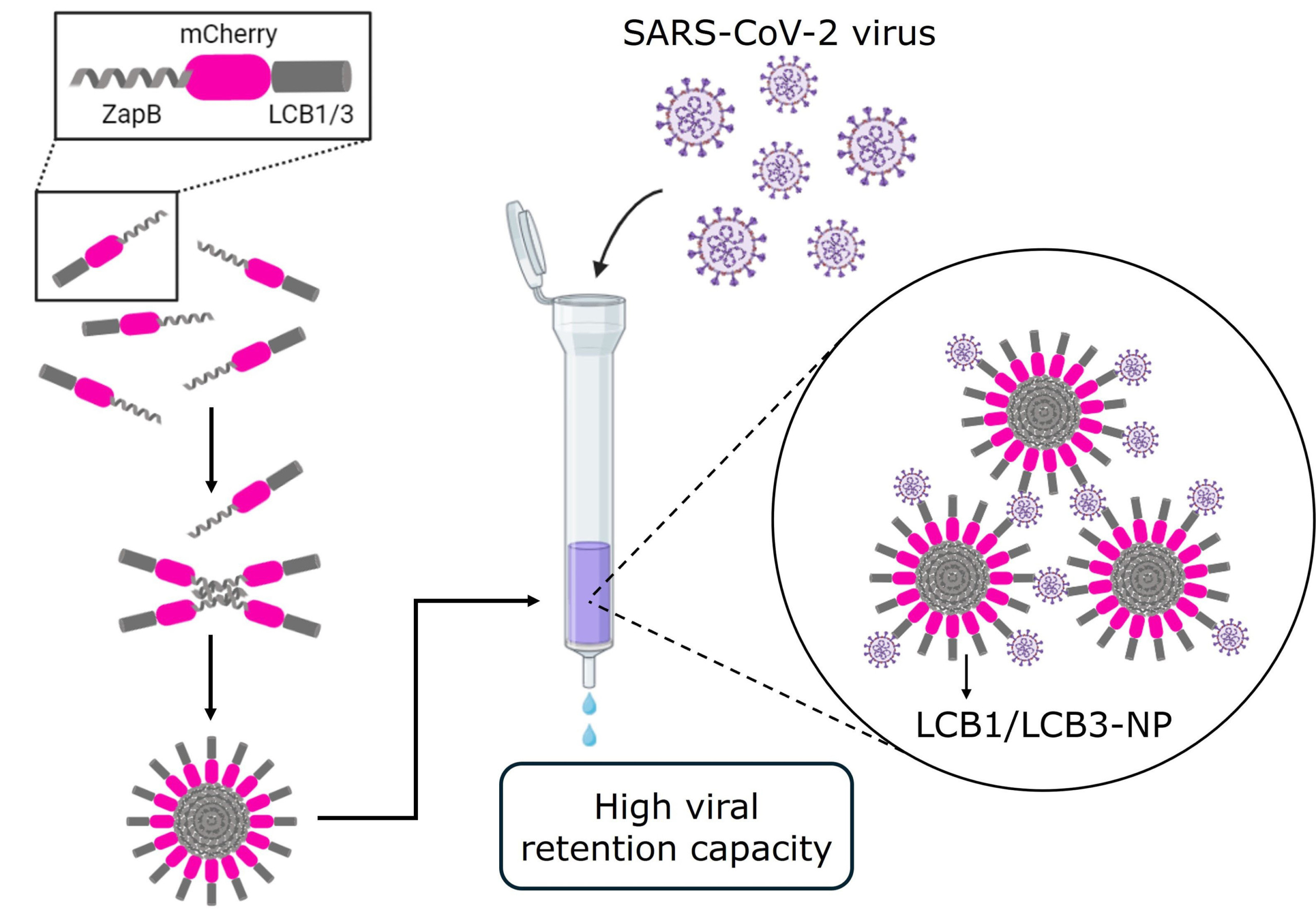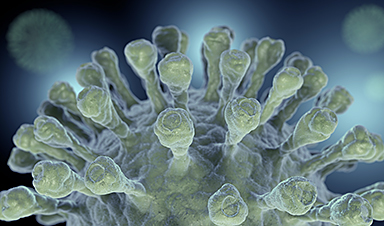| (Nanowerk News) Researchers from the IBB-UAB have developed a new class of nanostructures capable of trapping and neutralising large quantities of the SARS-CoV2 virus particles, both in liquid solutions and on the surface of materials. These novel nanoparticles could be used to manufacture antiviral materials such as wastewater and air filters, and could be exploited to develop new tests for the early detection of Covid-19. Moreover, the nanoparticles could be redesigned to target other pathogens. | |
| The study was led by researchers from the Institute for Biotechnology and Biomedicine of the Universitat Autònoma de Barcelona (IBB-UAB), who highlight the potential of the developed nanostructures for the manufacturing of new antiviral materials. | |
| The study was published in the journal Advanced Healthcare Materials (“Protein Nanoparticles for Targeted SARS-CoV-2 Trapping and Neutralization»”). | |
| The new nanoparticles, called LCB1-NPs and LCB3-NPs, are formed by repeats of three proteins, which are joined together thanks to the self-assembly properties of one of the three, called ZapB. In the genetic engineering strategy that was implemented, the researchers fused ZapB with the mCherry protein, which confers red fluorescence to the nanoparticles, and to this union they added the LCB1 and LCB3 proteins, which provide the ability to bind and neutralise the SARS-CoV-2 virus. Thus, by forming these nanostructures, it was possible to localise all these functions in a single nanoparticle. | |
 |
|
| Illustration of the formation of the new nanoparticles, LCB1-NPs and LCB3-NPs, designed by the IBB-UAB researchers. (Image: IBB-UAB) | |
| The researchers underscore the high affinity of the nanoparticles to bind to the viral spike protein that allows SARS-CoV2 internalization into cells. This process enables the nanoparticles to neutralise the infection in both liquid solutions and immobilised on a surface. This demonstrates the great versatility of this new antiviral nanomaterial, paving the way for its utilisation in a multitude of applications. | |
| “Each nanoparticle is composed of many LCB1 or LCB3 proteins, resulting in a high density of SARS-CoV-2 binding sites that allow each nanoparticle to bind to more than one virus. This greatly increases their potential as an antiviral material compared to other materials in which each nanostructure can only bind to one single particle of the virus,” explains IBB-UAB researcher Marc Fornt, first author of the study. | |
| The red fluorescence makes it easier to track and localize the nanoparticles with the naked eye, which makes them much easier to handle. | |
| An experiment using the nanoparticles to engineer a virus filter has allowed the researchers to demonstrate the ability of this new nanomaterial to trap and neutralise large quantities of SARS-CoV-2. Among its applications are the filtering of wastewater containing secretions from patients affected by Covid-19 to prevent them from reaching the water system, and the filtering of air in sensitive areas such as hospital wards. The nanoparticles could also be used in the manufacturing of new ultra-sensitive detection tests to diagnose the disease in the early stages of infection, when the viral load is still very low. | |
| “These new nanoparticles are also of great interest for the industrial production of antiviral materials due to the simplicity, speed and low cost involved in making them,” says IBB-UAB researcher and director of I3PT Salvador Ventura, who coordinated the study. | |
| The modular system through which the nanostructures were generated allows the protein that recognises and neutralises SARS-CoV-2 to be replaced by proteins that recognise other pathogens of interest. “This flexibility provides a solid framework for the generation of new materials to combat potential emerging infectious diseases effectively and rapidly, particularly if combined with recent advances in de novo protein design,” concludes Salvador Ventura. |
| Source: Universitat Autònoma de Barcelona (Note: Content may be edited for style and length) |
News
Does being infected or vaccinated first influence COVID-19 immunity?
A new study analyzing the immune response to COVID-19 in a Catalan cohort of health workers sheds light on an important question: does it matter whether a person was first infected or first vaccinated? [...]
We May Never Know if AI Is Conscious, Says Cambridge Philosopher
As claims about conscious AI grow louder, a Cambridge philosopher argues that we lack the evidence to know whether machines can truly be conscious, let alone morally significant. A philosopher at the University of [...]
AI Helped Scientists Stop a Virus With One Tiny Change
Using AI, researchers identified one tiny molecular interaction that viruses need to infect cells. Disrupting it stopped the virus before infection could begin. Washington State University scientists have uncovered a method to interfere with a key [...]
Deadly Hospital Fungus May Finally Have a Weakness
A deadly, drug-resistant hospital fungus may finally have a weakness—and scientists think they’ve found it. Researchers have identified a genetic process that could open the door to new treatments for a dangerous fungal infection [...]
Fever-Proof Bird Flu Variant Could Fuel the Next Pandemic
Bird flu viruses present a significant risk to humans because they can continue replicating at temperatures higher than a typical fever. Fever is one of the body’s main tools for slowing or stopping viral [...]
What could the future of nanoscience look like?
Society has a lot to thank for nanoscience. From improved health monitoring to reducing the size of electronics, scientists’ ability to delve deeper and better understand chemistry at the nanoscale has opened up numerous [...]
Scientists Melt Cancer’s Hidden “Power Hubs” and Stop Tumor Growth
Researchers discovered that in a rare kidney cancer, RNA builds droplet-like hubs that act as growth control centers inside tumor cells. By engineering a molecular switch to dissolve these hubs, they were able to halt cancer [...]
Platelet-inspired nanoparticles could improve treatment of inflammatory diseases
Scientists have developed platelet-inspired nanoparticles that deliver anti-inflammatory drugs directly to brain-computer interface implants, doubling their effectiveness. Scientists have found a way to improve the performance of brain-computer interface (BCI) electrodes by delivering anti-inflammatory drugs directly [...]
After 150 years, a new chapter in cancer therapy is finally beginning
For decades, researchers have been looking for ways to destroy cancer cells in a targeted manner without further weakening the body. But for many patients whose immune system is severely impaired by chemotherapy or radiation, [...]
Older chemical libraries show promise for fighting resistant strains of COVID-19 virus
SARS‑CoV‑2, the virus that causes COVID-19, continues to mutate, with some newer strains becoming less responsive to current antiviral treatments like Paxlovid. Now, University of California San Diego scientists and an international team of [...]
Lower doses of immunotherapy for skin cancer give better results, study suggests
According to a new study, lower doses of approved immunotherapy for malignant melanoma can give better results against tumors, while reducing side effects. This is reported by researchers at Karolinska Institutet in the Journal of the National [...]
Researchers highlight five pathways through which microplastics can harm the brain
Microplastics could be fueling neurodegenerative diseases like Alzheimer's and Parkinson's, with a new study highlighting five ways microplastics can trigger inflammation and damage in the brain. More than 57 million people live with dementia, [...]
Tiny Metal Nanodots Obliterate Cancer Cells While Largely Sparing Healthy Tissue
Scientists have developed tiny metal-oxide particles that push cancer cells past their stress limits while sparing healthy tissue. An international team led by RMIT University has developed tiny particles called nanodots, crafted from a metallic compound, [...]
Gold Nanoclusters Could Supercharge Quantum Computers
Researchers found that gold “super atoms” can behave like the atoms in top-tier quantum systems—only far easier to scale. These tiny clusters can be customized at the molecular level, offering a powerful, tunable foundation [...]
A single shot of HPV vaccine may be enough to fight cervical cancer, study finds
WASHINGTON -- A single HPV vaccination appears just as effective as two doses at preventing the viral infection that causes cervical cancer, researchers reported Wednesday. HPV, or human papillomavirus, is very common and spread [...]
New technique overcomes technological barrier in 3D brain imaging
Scientists at the Swiss Light Source SLS have succeeded in mapping a piece of brain tissue in 3D at unprecedented resolution using X-rays, non-destructively. The breakthrough overcomes a long-standing technological barrier that had limited [...]





















